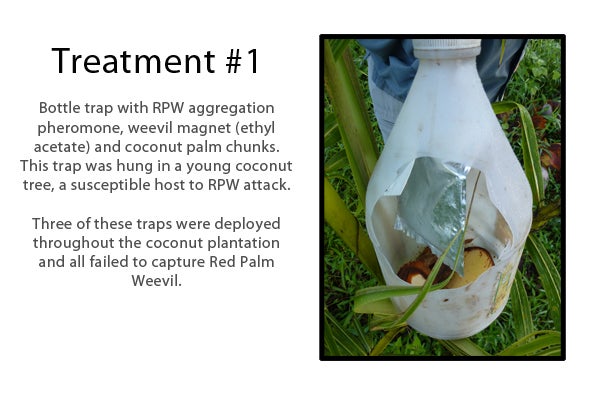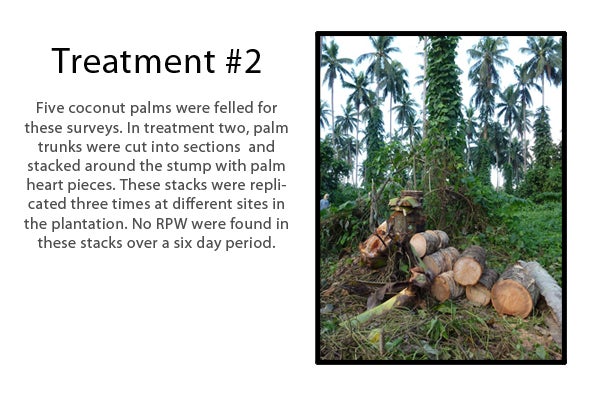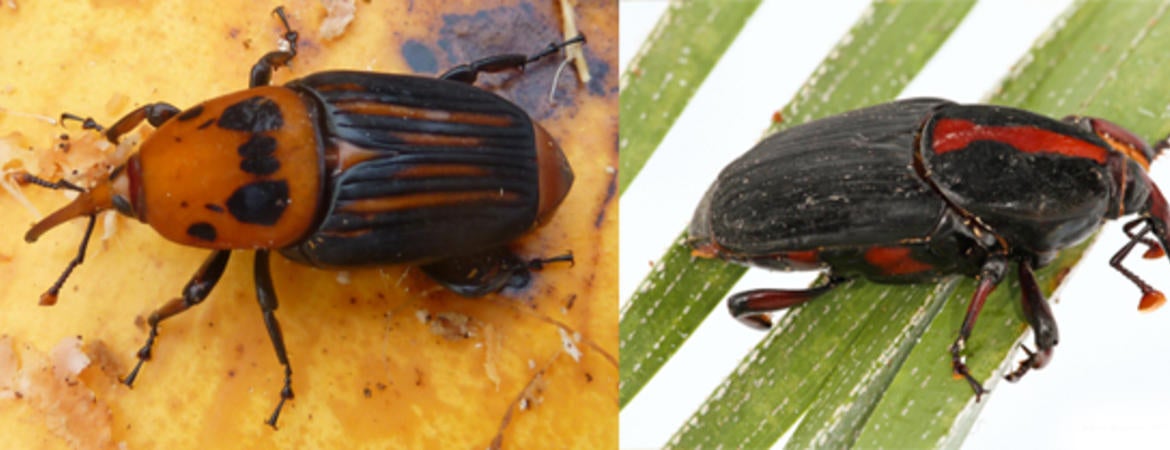
In August 2010, red palm weevil (RPW), was officially detected in Laguna Beach, Orange County California. This insect was recovered from a dying Canary Islands palm in a residential property and has been declared by FAO to be the world’s most destructive palm pest. At least 2-3 additional palms are thought to have been killed by this insect in Laguna Beach, and two Canary Islands palm trees showing RPW damage have been treated with insecticides. Intensive trapping efforts by CDFA for more than one year using the commercially-available RPW aggregation pheromone, ethyl acetate (weevil magnet), and fruit additives placed together in bucket traps have failed to capture RPW in the immediate vicinity of previous detection sites.
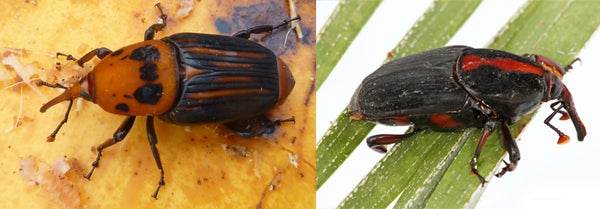
This pheromone-based trapping program has been used successfully for monitoring in other countries where the orange and black form of R. ferrugineus has invaded, and it is an important management component of IPM programs in Middle Eastern commercial date plantations for this pest.
A major point of interest regarding the trapping program in California using the commercially available RPW pheromone is whether or not it is attractive to the red palm weevil morph found in Laguna Beach. The RPW color morph found in Laguna Beach is black with a prominent dorsal red stripe that runs from the rear margin of the head across the thorax to the anterior margin of the abdomen. Until its detection in southern California this red stripe form of RPW was only known from southeast Asia (e.g., south Thailand, Malaysia, Indonesia, and the Philippines.)
To assess the attractiveness of the commercial RPW pheromone used by CDFA in Laguna Beach to the “vulneratus” morph, a small trial was run in a 60 ha commercial coconut plantation in Quezon on Luzon Island in the Philippines from 20 October 2011 to 26 October 2011. This area has been reported previously to have both RPW color morphs in sympatry. Three treatments were set up and checked twice per day at 6:00am and 4:00pm for captures of RPW:
Treatment one:This treatment consisted of traps with RPW aggregation pheromone + ethyl acetate (weevil magnet) + fermented dates. The aggregation pheromone and weevil magnet were supplied by CDFA and are the same products being used to monitor for RPW in Laguna Beach. Previous studies have demonstrated that fermented dates are an extremely potent “additive” to this set-up for attracting the orange and black morph of RPW. Dates were used for 3 days and then replaced with cut pieces of palm hearts. Traps were hung either in immature coconuts (a highly preferred host stage for RPW to attack) (see photo below) or on dead coconut trunks ~ 2.0 m above the ground (a height similar to that of CDFA deployed traps in Laguna Beach). This treatment was replicated three times in the plantation.
Treatment 2: Freshly felled coconut palms that were bucked, stacked, and had palm hearts arranged on the wood pile were inspected for RPW attracted to this resource. This treatment was replicated three times. The plantation owner was asked to fell five palms that were suspected to be infested with RPW. All five palms exhibited extensive internal damage, but no RPW life stages were found and it is was difficult to determine if feeding damage had been caused by RPW or another serious coconut pest, Oryctes rhinoceros beetles.
Treatment 3: This treatment consisted of Treatment one (bottle trap with RPW pheromone + ethyl acetate + fermented dates or palm hearts) and Treatment two combined and was replicated three times at different sites in the plantation.
Results: The results of these trials were clear cut and consistent. Treatments one and two did not result in the capture of any RPW over the 6 day monitoring period. Treatment three, pheromone bottle traps placed on freshly cut stumps of coconut palms with cut sections of palm trunk and palm hearts resulted in the capture of 23 RPW over the course of the trial. All three replicates of Treatment three resulted in the capture of RPW and the first captures were made ~ 24 hr after the palms were felled, sectioned, and stacked with the pheromone bottle trap. Captures ranged from 1 – 5 RPW at a site. RPW were found either inside the bottle traps, or more often underneath the wood stacked on top of the palm stump, or in chainsaw blade width slices made into bucked pieces of palm trunk. Adults are exceptionally thigmotactic and can push themselves deeply into very tight crevices, hence the notches on the cut pieces of palm trunk.
The color morphs of RPW that were captured in Treatment three included R. ferrugineus, “R. vulneratus”, and a color and pattern spectrum between these two distinct forms.

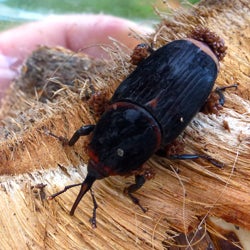
The sex ratio of captured RPW was highly female biased (n = 18 females [78%]; n = 5 males [22%]). Unidentified phoretic mites were found on 60% and 67% of males and females, respectively. Phoretic mites have been recorded previously on RPW adults but their potential role as control agents of RPW is uncertain.
The majority, 78% (n = 18) of RPW were captured when treatments were examined at 6:00am, the remaining 22% (n = 5) were captured at 5:00pm. This result suggests the RPW flight activity in the Philippines may be crepuscular or nocturnal.
Conclusions: The RPW traps baited with pheromone and weevil magnet (ethyl acetate) used by CDFA in Laguna Beach failed to capture any weevils in a commercial coconut plantation in the Philippines unless they were deployed in conjunction with freshly felled coconut palms. The pheromone + weevil magnet + fruit additives alone did not catch any weevils, nor did the fresh-cut palm logs attract any weevils. The reasons for this are not clear. This small study had low treatment replication and treatments were not blocked to account for site effects – although they were dispersed widely through the plantation. The bottle traps may not have been adequate for retaining RPW attracted to Treatment 1. This trial was run at the end of the monsoon season, a time of year reported to have low RPW activity. This situation may have been worsened by a wetter than normal “dry” season (the owner of the coconut plantation indicated that the dry season had been unusually wet this year) that preceded the monsoon season and RPW densities may have been lower than normal for this time period.
Thus, our results suggest that the bait combinations being used in Laguna Beach may not attractive to the RPW morph that is present. Our results suggest that at a minimum, pheromone and weevil magnet baits should be deployed in combination with fresh-cut palm material, especially newly cut palm trunks and if possible this treatment should be set up and trialed in Laguna Beach to see if it can attract and retain RPW.
